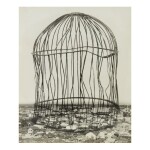Classic Photographs
Classic Photographs

KANSUKE YAMAMOTO | REMINISCENCE
Auction Closed
October 3, 04:15 PM GMT
Estimate
20,000 - 30,000 USD
Lot Details
Description
KANSUKE YAMAMOTO
1914-1987
REMINISCENCE
possibly ferrotyped, signed and with annotation 'TSG Catalogue #93' by Toshio Yamamoto, the photographer's son, in pencil and the photographer's credit, copyright, and estate stamps, dated '53,' in pencil on the reverse, cornered to a mount, embossed, stamped, and annotated 'TSG Catalogue #93' by Toshio Yamamoto in pencil on the mount, framed, 1953
12¼ by 10 in. (31.1 by 25.4 cm.)
Judith Keller and Amanda Maddox, eds., Japan's Modern Divide: the Photographs of Hiroshi Hamaya and Kansuke Yamamoto (Los Angeles: The J. Paul Getty Museum, 2013), pl. 70 (this print)
Legend of a Buddhist Temple (by Kansuke Yamamoto)
a birdcage without a bird and
from a garden without a birdcage with a bird
countless sparks rise up
like a Hindu saint’s apocalypse
along the line of the white Coliseum
shaking the even more grotesque Colossus
sending a sign of the night’s festival
the body writhes like a hummingbird
leaning a cheek on the fingers of a heathen
giving a fierce numbness
(from Kokaku, 1940)
Attentive to international developments in artistic practices of his time, Yamamoto incorporated Surrealism and photocollage into his work from the early 1930s. It is important to note, however, that ‘. . . Yamamoto did not cavalierly adopt the expressive technique of collage from the European avant-garde; he did not use collage for merely its aesthetic and stylistic elements. Rather, he was able to show that this technique was well suited for sharp social criticism, and he used it in the specific context of Japan’ (Japan's Modern Divide, Ryuichi Kaneko, p. 164). He conveyed his political views and critique of contemporary Japanese society through his creative output, which included photographs, poems, newspaper articles, translations and his teaching, and strongly believed in Surrealism as a powerful political weapon.
The birdcage is a recurring motif in Yamamoto’s photography and poetry. He thought of the bird as the most advanced of all beings because it has the ability and freedom to fly. The present image of the cage, its rusty bars mangled and burned, is overlaid on a Japanese city to create an image evocative of the devastating aftermath of the atomic bomb. As ‘housing’ for an animal, the cage is connected to the human houses underneath, alluding to the entrapment of the unseen population of the city below. In this work and many of his other Surrealist photocollages, Yamamoto communicates his frustration with the Japanese state of mind, regulations of freedom and free expression, and the postwar occupation of U. S. military forces. Despite its often somber implications, Yamamoto’s bird/birdcage symbolism perhaps carries some hopeful undertones. The cage in the photocollage as well as in the poem above, is decidedly empty; no bird is caught inside, suggesting that there is hope for Japan and its people. ‘Yamamoto was trying to wake up Japan in order to encourage it to dream’ (Ibid., Amanda Maddox, p. 202).
